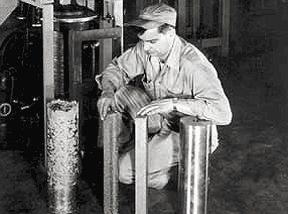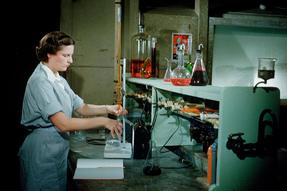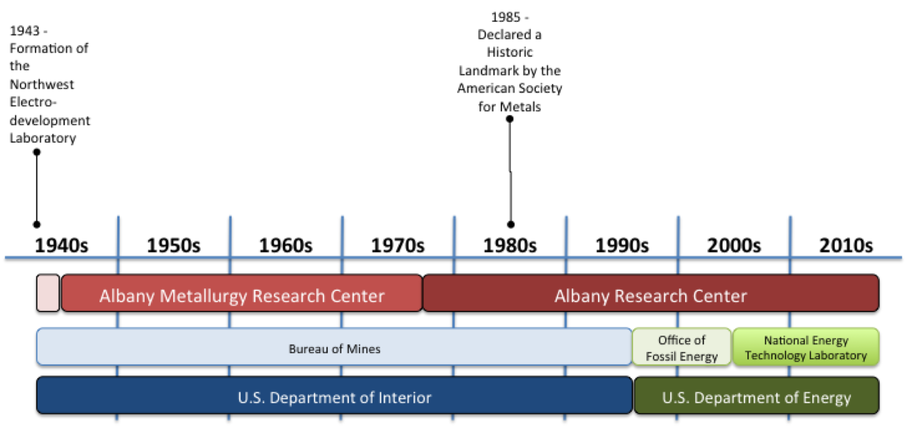For more than 70 years, research at the Albany Research Center (ARC) has advanced the frontiers of science and engineering in the fields of materials engineering, energy technologies, thermodynamics, geochemistry, geology, geography, data science and computer science.
Innovation at the ARC stems back to 1943 when President Franklin D. Roosevelt announced plans for the new U.S. Bureau of Mines Northwest Electro-development Laboratory in Albany, OR. Built to develop novel metallurgical processes, the laboratory developed unique facilities and quickly became a leader in the design, development, and deployment of new, advanced materials important to the Cold War to come.
Early research by Dr. William J. Kroll and other researchers were vital to the development of new processes that gave birth to the titanium and zirconium industries. Other work at ARC supported the development of the first nuclear-powered submarine, the USS Nautilus (SSN-571) in cooperation with the U.S. Navy and the Atomic Energy Commission. In addition, research on titanium castings, recycling metals and alloys, creation of sulfurcrete, evaporative pattern casting, cold-wall induction melting, metal corrosion, and other areas have fostered the development of new businesses and the metals and materials industry in Oregon.
Over the decades, scientists at ARC have contributed extensively in the fields of metals and minerals research, generating a number of patents and leading to the naming of the Center as a historical landmark by the American Society for Metals in 1985. When the U.S. Bureau of Mines closed on February 3, 1996, the Center was transferred to the U.S. Department of Energy, Office of Fossil Energy. On November 27, 2005, the Center joined the agency's national laboratory complex as the newest branch of the National Energy Technology Laboratory (NETL).
Research at ARC as part of NETL has continued to make unique contributions to materials science as well as fostering new innovations in the fields of energy, geochemistry, geology, geography, and computer science.
2021:
2020:
2019:
2018:
2017:
2016:
2015:
2013:
2012:
2011:
2010:
Early research by Dr. William J. Kroll and other researchers were vital to the development of new processes that gave birth to the titanium and zirconium industries. Other work at ARC supported the development of the first nuclear-powered submarine, the USS Nautilus (SSN-571) in cooperation with the U.S. Navy and the Atomic Energy Commission. In addition, research on titanium castings, recycling metals and alloys, creation of sulfurcrete, evaporative pattern casting, cold-wall induction melting, metal corrosion, and other areas have fostered the development of new businesses and the metals and materials industry in Oregon.
Over the decades, scientists at ARC have contributed extensively in the fields of metals and minerals research, generating a number of patents and leading to the naming of the Center as a historical landmark by the American Society for Metals in 1985. When the U.S. Bureau of Mines closed on February 3, 1996, the Center was transferred to the U.S. Department of Energy, Office of Fossil Energy. On November 27, 2005, the Center joined the agency's national laboratory complex as the newest branch of the National Energy Technology Laboratory (NETL).
Research at ARC as part of NETL has continued to make unique contributions to materials science as well as fostering new innovations in the fields of energy, geochemistry, geology, geography, and computer science.
2021:
- NETL Albany researcher Margaret Ziomek-Moroz received the 2021 NACE Fellows honor, becoming a member of the class of NACE Fellows for her sustained and widely recognized contributions to corrosion control.
2020:
- Current NETL Albany researchers David E. Alman and Michael Gao, and former NETL Albany researchers David Maurice and James Rawers identified as in the top 2% of world researchers in the journal PLOS Biology.
- Richard Oleksak received the Young Leaders Professional Development Award within the Structural Materials Division of TMS.
2019:
- R&D 100 Award for Offshore Risk Modeling suite of computational tools. A flexible set of custom data, tools, and models that integrate innovative spatio-temporal analytics, machine learning, big data, and advanced visualization technologies.
- Carnegie Science Award for Global Oil and Gas Infrastructure (GOGI). The first open-source database of oil and natural gas infrastructure information that offers insights on each country’s hydrocarbon footprint. This groundbreaking achievement provides an invaluable technological tool for predicting and assessing global methane emissions risks, providing a big-data platform to assess local hydrocarbon infrastructure needs, identifying information gaps, evaluating economic costs, and supporting a range of critical decision-making needs. Research teams from all over the world can access authoritative information needed to make critical decisions when developing oil and gas infrastructure and take energy-saving action to reduce methane leaks.
- Federal Employee Excellence Awards presented by the Oregon Federal Executive Board (FEB). Stephen Curman was awarded the Unsung Hero Award, and Marisa Arnold was recognized in the Leadership category.
2018:
- Federal Employee Excellence Awards presented by the Oregon Federal Executive Board (FEB). NETL researchers Kelly Rose, Ph.D., and Circe Verba, Ph.D., were honored with two of the top awards. Rose, a Geo-Data Science Researcher, won the Exceptional Service Award, while Verba, a Research Geologist, took home the Leadership Award. Rose and Verba are both part of NETL’s Geology and Geospatial Analysis Team, working to characterize and understand the behavior of engineered and natural systems as it relates to innovative energy technologies. Alan Hartman, the Lab’s Albany Site Operations Manager, was recognized in the Customer Service Award category.
2017:
- R&D 100 Award for Computationally Optimized Heat Treatment of Metal Alloys—Conventional processes for homogenizing metal alloys are trial-and-error in their approach, resulting in increased process cost and limits to the possible paths that may be explored. NETL’s Computationally Optimized Homogenization Heat Treatment Process provides an easy method to optimize heat treatment to achieve the desired degree of homogenization with a minimum of furnace time.
- Award - pitch contest (Dr. Kelly Rose)
2016:
- Federal Executive Board, Women of the Year Gold Award: Dr. Circe Verba
2015:
- ASM Engineering Materials Achievement Award for the development, transfer, and successful commercialization of a novel platinum-chromium alloy used in next-generation coronary stents.
2013:
- R&D 100 Award for Arc Position Sensing - Vacuum arc remelting (VAR) is the primary method for melting and refining specialty metals for aerospace and other advanced applications. NETL’s Arc Position Sensing (APS) technology allows operators to digitally monitor arc location during melting, identifying deleterious operating conditions quickly and avoiding known conditions that may lead to defects.
- Federal Laboratory Consortium: Outstanding Technology Development for heat-resistant alloys contain a variety of elemental components that are hard to control during the melt-solidification processing stage. NETL has developed a computational algorithm using commercially available thermodynamic and kinetic software to design a customized homogenization schedule that delivers a predetermined and desired level of homogenization to an alloy using conventional furnace capabilities.
- Carnegie Science Award: Advanced Materials Award for NETL’s platinum-chromium (Pt-Cr) alloy was selected for the Advanced Materials Award, which honors “accomplishments in materials science that create new materials or properties leading to significant business, economic, or societal benefits for the region."
2012:
- Secretary of Energy Achievement Award for NETL’s coronary stents team, Paul Turner and Paul Jablonski of NETL and Ed Argetsinger of URS, earned a Secretary of Energy Achievement Award for their work in formulating a unique platinum-chromium alloy used for new-generation coronary stents.
2011:
- Federal Laboratory Consortium: Outstanding Commercialization Success for the development of a Platinum-Chromium Alloy for the manufacture of Improved Coronary Stents
- NACE International Western Region Engineer of the Year was awarded to Gordon Holcomb in recognition of outstanding technical contributions to the field of corrosion engineering.
2010:
- Federal Laboratory Consortium: Outstanding Commercialization Success for Aurex(r) 95
- Federal Laboratory Consortium: Outstanding Technology Development for Cerium Oxide Coating for Oxidation Rate Reduction in Stainless Steels and Nickel Superalloys



